Research Progress on the Typical Variants of Simulated Moving Bed: From the Established Processes to the Advanced Technologies
Abstract
:1. Introduction
2. Zone Variant
2.1. One-Column SMB
2.2. Two-Zone SMB
2.3. Three-Zone SMB
2.3.1. Three-Zone SMB without Zone IV
2.3.2. Three-Zone SMB without Zone I
2.3.3. Port Variant
2.3.4. Other Variants
2.3.5. Applications for Three-Zone SMB
2.4. Bypass SMB
2.5. SMBs with More Than Four Zones
3. Gradient Variant
3.1. Concentration Gradient
3.2. Temperature Gradient
3.3. Pressure Gradient
4. Feed or Operation Variant
4.1. ModiCon
4.2. VariCol
4.3. PowerFeed
4.4. Intermittent Simulated Moving Bed (ISMB)
4.5. Sequential Simulated Moving Bed (SSMB)
4.6. Pseudo-SMB
4.7. Outlet Swing Stream (OSS) SMB
4.8. Backfill-SMB (BF-SMB)
4.9. SMB Cascades
4.10. SimCon
5. Conclusions
Author Contributions
Funding
Data Availability Statement
Acknowledgments
Conflicts of Interest
References
- Ruthven, D.M.; Ching, C.B. Counter-current and simulated counter-current adsorption separation processes. Chem. Eng. Sci. 1989, 44, 1011–1038. [Google Scholar] [CrossRef]
- Deveant, R.M.; Jonas, R.; Schulte, M.; Keil, A.; Charton, F. Enantiomer Separation of a Novel Ca-Sensitizing Drug by simulated moving bed (SMB)-chromatography. J. Für Prakt. Chem./Chem.-Ztg. 1997, 339, 315–321. [Google Scholar] [CrossRef]
- Francotte, E.; Richert, P.; Mazzotti, M.; Morbidelli, M. Simulated moving bed chromatographic resolution of a chiral antitussive. J. Chromatogr. A 1998, 796, 239–248. [Google Scholar] [CrossRef]
- Juza, M.; Mazzotti, M.; Morbidelli, M. Simulated moving-bed chromatography and its application to chirotechnology. Trends Biotechnol. 2000, 18, 108–118. [Google Scholar] [CrossRef]
- Nagy, M.Z.M.; Hanák, L.; Argyelán, J.; Szánya, T.; Ravasz, B.; Aranyi, A. Temesvári Separation of Organic Compounds by Simulated Moving Bed Preparative Liquid Chromatography. Chromatographia 2004, 60, S181–S187. [Google Scholar] [CrossRef]
- Houwing, J.; Billiet, H.A.H.; van der Wielen, L.A.M. Optimization of azeotropic protein separations in gradient and isocratic ion-exchange simulated moving bed chromatography. J. Chromatogr. A 2002, 944, 189–201. [Google Scholar] [CrossRef] [PubMed]
- Antos, D.; Seidel-Morgenstern, A. Two-step solvent gradients in simulated moving bed chromatography. J. Chromatogr. A 2002, 944, 77–91. [Google Scholar] [CrossRef]
- Szanya, T.; Argyelan, J.; Kovats, S.; Hanak, L. Separation of steroid compounds by overloaded preparative chromatography with precipitation in the fluid phase. J. Chromatogr. A 2001, 908, 265–272. [Google Scholar] [CrossRef] [PubMed]
- Pynnonen, B. Simulated moving bed processing: Escape from the high-cost box. J. Chromatogr. A 1998, 827, 143–160. [Google Scholar] [CrossRef]
- Zhong, G.; Guiochon, G. Steady-state analysis of simulated moving-bed chromatography using the linear, ideal model. Chem. Eng. Sci. 1998, 53, 1121–1130. [Google Scholar] [CrossRef]
- Pais, L.S.; Loureiro, J.; Rodrigues, A.E. Separation of 1,1′-bi-2-naphthol enantiomers by continuous chromatography in simulated moving bed. Chem. Eng. Sci. 1997, 52, 245–257. [Google Scholar] [CrossRef]
- Wu, D.J.; Xie, Y.; Ma, Z.; Wang, N.H.L. Design of Simulated Moving Bed Chromatography for Amino Acid Separations. Ind. Eng. Chem. Res. 1998, 37, 4023–4035. [Google Scholar] [CrossRef]
- Zhang, Y.; Hidajat, K.; Ray, A.K. Modified reactive SMB for production of high concentrated fructose syrup by isomerization of glucose to fructose. Biochem. Eng. J. 2007, 35, 341–351. [Google Scholar] [CrossRef]
- Yu, W.; Hidajat, K.; Ray, A.K. Optimal operation of reactive simulated moving bed and Varicol systems. J. Chem. Technol. Biotechnol. 2003, 78, 287–293. [Google Scholar] [CrossRef]
- Rajendran, A.; Paredes, G.; Mazzotti, M. Simulated moving bed chromatography for the separation of enantiomers. J. Chromatogr. A 2009, 1216, 709–738. [Google Scholar] [CrossRef]
- Kim, Y.; Cho, S.; Jang, K.; Lee, J.; Kim, M.; Moon, I. Effect of radial distribution of injected flow on simulated moving bed performance. J. Chromatogr. A 2022, 1662, 462703. [Google Scholar] [CrossRef]
- Kim, K.-M.; Lee, J.W.; Kim, S.; Santos da Silva, F.V.; Seidel-Morgenstern, A.; Lee, C.-H. Advanced Operating Strategies to Extend the Applications of Simulated Moving Bed Chromatography. Chem. Eng. Technol. 2017, 40, 2163–2178. [Google Scholar] [CrossRef]
- Toumi, A.; Engell, S.; Ludemann-Hombourger, O.; Nicoud, R.M.; Bailly, M. Optimization of simulated moving bed and Varicol processes. J. Chromatogr. A 2003, 1006, 15–31. [Google Scholar] [CrossRef] [PubMed]
- Calderon Supelano, R.; Barreto, A.G., Jr.; Andrade Neto, A.S.; Secchi, A.R. One-step optimization strategy in the simulated moving bed process with asynchronous movement of ports: A VariCol case study. J. Chromatogr. A 2020, 1634, 461672. [Google Scholar] [CrossRef]
- Zang, Y.; Wankat, P.C. Variable Flow Rate Operation for Simulated Moving Bed Separation Systems: Simulation and Optimization. Ind. Eng. Chem. Res. 2003, 42, 4840–4848. [Google Scholar] [CrossRef]
- Wang, J.; Tian, Y.; Li, Y.; Xu, J.; Yu, W.; Ray, A.K. Multi-objective optimization of non-isothermal simulated moving bed reactor: Methyl acetate synthesis. Chem. Eng. J. 2020, 395, 125041. [Google Scholar] [CrossRef]
- Wei, F.; Shi, L.; Wang, Q.; Zhao, Y. Fast and accurate separation of the paclitaxel from yew extracum by a pseudo simulated moving bed with solvent gradient. J. Chromatogr. A 2018, 1564, 120–127. [Google Scholar] [CrossRef] [PubMed]
- Cristancho, C.A.M.; Seidel-Morgenstern, A. Purification of single-chain antibody fragments exploiting pH-gradients in simulated moving bed chromatography. J. Chromatogr. A 2016, 1434, 29–38. [Google Scholar] [CrossRef]
- Li, Y.; Xu, J.; Yu, W.; Ray, A.K. Multi-objective optimization of sequential simulated moving bed for the purification of xylo-oligosaccharides. Chem. Eng. Sci. 2020, 211, 115279. [Google Scholar] [CrossRef]
- Aniceto, J.P.S.; Silva, C.M. Simulated moving bed strategies and designs: From established systems to the latest developments. Sep. Purif. Rev. 2015, 44, 41–73. [Google Scholar] [CrossRef]
- Faria, R.P.V.; Rodrigues, A.E. Instrumental aspects of simulated moving bed chromatography. J. Chromatog-Raphy A 2015, 1421, 82–102. [Google Scholar] [CrossRef]
- Lee, C.G.; Jo, C.Y.; Song, Y.J.; Mun, S. Continuous-mode separation of fucose and 2,3-butanediol using a three-zone simulated moving bed process and its performance improvement by using partial extract-collection, partial extract-recycle, and partial desorbent-port closing. J. Chromatogr. A 2018, 1579, 49–59. [Google Scholar] [CrossRef]
- Ching, C.B.; Chu, K.H.; Hidajat, K.; Uddin, M.S. Comparative study of flow schemes for a simulated countercurrent adsorption separation process. AIChE J. 1992, 38, 1744–1750. [Google Scholar] [CrossRef]
- Hur, J.S.; Wankat, P.C. Two-Zone SMB/Chromatography for Center-Cut Separation from Ternary Mixtures: Linear Isotherm Systems. Ind. Eng. Chem. Res. 2006, 45, 1426–1433. [Google Scholar] [CrossRef]
- Mun, S. Relationship between desorbent usage and the recovery of a target product in three-zone simulated moving bed processes designed under the conditions of positive and negative flow-rate-ratios of liquid to solid phases. J. Chromatogr. A 2019, 1603, 388–395. [Google Scholar] [CrossRef]
- Ching, C.B.; Ruthven, D.M. Analysis of the performance of a simulated counter-current chromatographic system for fructose-glucose separation. Can. J. Chem. Eng. 1984, 62, 398–403. [Google Scholar] [CrossRef]
- Barker, P.E.; Knoechelmann, A.; Ganetsos, G. Simulated counter-current moving column chromatography used in the continuous separation of carbohydrate mixtures. Chromatographia 1990, 29, 161–166. [Google Scholar] [CrossRef]
- Hashimoto, K.; Yamada, M.; Adachi, S.; Shirai, Y. A simulated moving-bed adsorber with three zones for continuous separation of L-phenylalanine and NaCl. J. Chem. Eng. Jpn. 1989, 22, 432–434. [Google Scholar] [CrossRef]
- Abunasser, N.; Wankat, P.C.; Kim, Y.S.; Koo, Y.M. One-column chromatograph with recycle analogous to a four-zone simulated moving bed. Ind. Eng. Chem. Res. 2003, 42, 5268–5279. [Google Scholar] [CrossRef]
- Abunasser, N.; Wankat, P.C. One-column chromatograph with recycle analogous to simulated moving bed adsorbers: Analysis and applications. Ind. Eng. Chem. Res. 2004, 43, 5291–5299. [Google Scholar] [CrossRef]
- Lee, K. Two-Section Simulated Moving-Bed Process. Sep. Sci. Technol. 2000, 35, 519–534. [Google Scholar] [CrossRef]
- Jin, W.; Wankat, P.C. Two-Zone SMB Process for Binary Separation. Ind. Eng. Chem. Res. 2005, 44, 1565–1575. [Google Scholar] [CrossRef]
- Nam, H.-G.; Mun, S. Optimal design and experimental validation of a three-zone simulated moving bed process based on the Amberchrom-CG161C adsorbent for continuous removal of acetic acid from biomass hydrolyzate. Process Biochem. 2012, 47, 725–734. [Google Scholar] [CrossRef]
- Zang, Y.; Wankat, P.C. Three-Zone Simulated Moving Bed with Partial Feed and Selective Withdrawal. Ind. Eng. Chem. Res. 2002, 41, 5283–5289. [Google Scholar] [CrossRef]
- Peng, B.; Wang, S. Separation of p-xylene and m-xylene by simulated moving bed chromatography with MIL-53(Fe) as stationary phase. J. Chromatogr. A 2022, 1673, 463091. [Google Scholar] [CrossRef]
- Kung, H.-C.; Liang, K.-Y.; Mutuku, J.K.; Huang, B.-W.; Chang-Chien, G.-P. Separation and purification of caulerpin from algal Caulerpa racemosa by simulated moving bed chromatography. Food Bioprod. Process. 2021, 130, 14–22. [Google Scholar] [CrossRef]
- Wei, B.; Wang, S. Separation of eicosapentaenoic acid and docosahexaenoic acid by three-zone simulated moving bed chromatography. J. Chromatogr. A 2020, 1625, 461326. [Google Scholar] [CrossRef] [PubMed]
- Shen, B.; Chen, M.; Jiang, H.; Zhao, Y.; Wei, F. Modeling Study on a Three-Zone Simulated Moving Bed without Zone I. Sep. Sci. Technol. 2011, 46, 695–701. [Google Scholar] [CrossRef]
- Kim, K.M.; Song, J.Y.; Lee, C.H. Three-port operation in three-zone simulated moving bed chromatography. J. Chromatogr. A 2014, 1340, 79–89. [Google Scholar] [CrossRef]
- Keβler, L.C.; Gueorguieva, L.; Rinas, U.; Seidel-Morgenstern, A. Step gradients in 3-zone simulated moving bed chromatography. Application to the purification of antibodies and bone morphogenetic protein-2. J. Chromatogr. A 2007, 1176, 69–78. [Google Scholar] [CrossRef]
- Song, S.-M.; Park, M.-B.; Kim, I.H. Three-zone simulated moving-bed (SMB) for separation of cytosine and guanine. Korean J. Chem. Eng. 2012, 29, 952–958. [Google Scholar] [CrossRef]
- Song, S.-M.; Kim, I.H. A three-zone simulated moving-bed for separation of immunoglobulin Y. Korean J. Chem. Eng. 2013, 30, 1527–1532. [Google Scholar] [CrossRef]
- Cunha, F.C.; Secchi, A.R.; de Souza, M.B., Jr.; Barreto, A.G., Jr. Separation of praziquantel enantiomers using simulated moving bed chromatographic unit with performance designed for semipreparative applications. Chirality 2019, 31, 583–591. [Google Scholar] [CrossRef]
- Yao, C.; Chen, J.; Lu, Y.; Tang, S.; Fan, E. Construction of an asynchronous three-zone simulated-moving-bed chromatography and its application for the separation of vanillin and syringaldehyde. Chem. Eng. J. 2018, 331, 644–651. [Google Scholar] [CrossRef]
- Tangpromphan, P.; Duangsrisai, S.; Jaree, A. Development of separation method for Alpha-Tocopherol and Gamma-Oryzanol extracted from rice bran oil using Three-Zone simulated moving bed process. Sep. Purif. Technol. 2021, 272, 118930. [Google Scholar] [CrossRef]
- Tangpromphan, P.; Budman, H.; Jaree, A. A simplified strategy to reduce the desorbent consumption and equipment installed in a three-zone simulated moving bed process for the separation of glucose and fructose. Chem. Eng. Process.-Process Intensif. 2018, 126, 23–37. [Google Scholar] [CrossRef]
- Nam, H.-G.; Park, C.; Jo, S.-H.; Suh, Y.-W.; Mun, S. Continuous separation of succinic acid and lactic acid by using a three-zone simulated moving bed process packed with Amberchrom-CG300C. Process Biochem. 2012, 47, 2418–2426. [Google Scholar] [CrossRef]
- Maruyama, R.T.; Karnal, P.; Sainio, T.; Rajendran, A. Design of bypass-simulated moving bed chromatography for reduced purity requirements. Chem. Eng. Sci. 2019, 205, 401–413. [Google Scholar] [CrossRef]
- Xie, Y.; Chin, C.Y.; Phelps, D.S.C.; Lee, C.H.; Lee, K.B.; Mun, S.; Wang, N.H.L. A Five-Zone Simulated Moving Bed for the Isolation of Six Sugars from Biomass Hydrolyzate. Ind. Eng. Chem. Res. 2005, 44, 9904–9920. [Google Scholar] [CrossRef]
- Wooley, R.; Ma, Z.; Wang, N.H.L. A Nine-Zone Simulating Moving Bed for the Recovery of Glucose and Xylose from Biomass Hydrolyzate. Ind. Eng. Chem. Res. 1998, 37, 3699–3709. [Google Scholar] [CrossRef]
- Jiang, C.; Huang, F.; Wei, F. A pseudo three-zone simulated moving bed with solvent gradient for quaternary separations. J. Chromatogr. A 2014, 1334, 87–91. [Google Scholar] [CrossRef]
- Antos, D.; Seidel-Morgenstern, A. Application of gradients in the simulated moving bed process. Chem. Eng. Sci. 2001, 56, 6667–6682. [Google Scholar] [CrossRef]
- Abel, S.; Mazzotti, M.; Morbidelli, M. Solvent gradient operation of simulated moving beds. J. Chromatogr. A 2002, 944, 23–39. [Google Scholar] [CrossRef]
- Abel, S.; Mazzotti, M.; Morbidelli, M. Solvent gradient operation of simulated moving beds. 2. Langmuir isotherms. J. Chromatogr. A 2004, 1026, 47–55. [Google Scholar] [CrossRef]
- Mun, S.; Wang, N.-H.L. Optimization of productivity in solvent gradient simulated moving bed for paclitaxel purification. Process Biochem. 2008, 43, 1407–1418. [Google Scholar] [CrossRef]
- Mun, S. Optimal Design of Solvent Gradient Simulated Moving Bed Chromatography for Amino Acid Separation. J. Liq. Chromatogr. Relat. Technol. 2011, 34, 1518–1535. [Google Scholar] [CrossRef]
- Kim, J.K.; Abunasser, N.; Wankat, P.C.; Stawarz, A.; Koo, Y.-M. Thermally Assisted Simulated Moving Bed Systems. Adsorption 2005, 11, 579–584. [Google Scholar] [CrossRef]
- Jin, W.; Wankat, P.C. Thermal Operation of Four-Zone Simulated Moving Beds. Ind. Eng. Chem. Res. 2007, 46, 7208–7220. [Google Scholar] [CrossRef]
- Migliorini, C.; Wendlinger, M.; Mazzotti, M.; Morbidelli, M. Temperature Gradient Operation of a Simulated Moving Bed Unit. Ind. Eng. Chem. Res. 2001, 40, 2606–2617. [Google Scholar] [CrossRef]
- Jiang, X.; Zhu, L.; Yu, B.; Su, Q.; Xu, J.; Yu, W. Analyses of simulated moving bed with internal temperature gradients for binary separation of ketoprofen enantiomers using multi-objective optimization: Linear equilibria. J. Chromatogr. A 2018, 1531, 131–142. [Google Scholar] [CrossRef]
- Mazzotti, M.; Storti, G.; Morbidelli, M. Supercritical fluid simulated moving bed chromatography. J. Chromatogr. A 1997, 786, 309–320. [Google Scholar] [CrossRef]
- Schramm, H.; Kaspereit, M.; Kienle, A.; Seidel-Morgenstern, A. Improving Simulated Moving Bed Processes by Cyclic Modulation of the Feed Concentration. Chem. Eng. Technol. 2002, 25, 1151–1155. [Google Scholar] [CrossRef]
- Schramm, H.; Kienle, A.; Kaspereit, M.; Seidel-Morgenstern, A. Improved operation of simulated moving bed processes through cyclic modulation of feed flow and feed concentration. Chem. Eng. Sci. 2003, 58, 5217–5227. [Google Scholar] [CrossRef]
- Lübke, R.; Seidel-Morgenstern, A.; Tobiska, L. Numerical method for accelerated calculation of cyclic steady state of ModiCon–SMB-processes. Comput. Chem. Eng. 2007, 31, 258–267. [Google Scholar] [CrossRef]
- Ludemann-Hombourger, O.; Nicoud, R.M.; Bailly, M. The “VARICOL” Process: A New Multicolumn Continuous Chromatographic Process. Sep. Sci. Technol. 2000, 35, 1829–1862. [Google Scholar] [CrossRef]
- Zhang, Z.; Hidajat, K.; Ray, A.K.; Morbidelli, M. Multiobjective optimization of SMB and varicol process for chiral separation. AIChE J. 2002, 48, 2800–2816. [Google Scholar] [CrossRef]
- Zhang, Y.; Hidajat, K.; Ray, A.K. Multi-objective optimization of simulated moving bed and Varicol processes for enantio-separation of racemic pindolol. Sep. Purif. Technol. 2009, 65, 311–321. [Google Scholar] [CrossRef]
- Zhang, Y.; Hidajat, K.; Ray, A.K. Enantio-separation of racemic pindolol on α1-acid glycoprotein chiral stationary phase by SMB and Varicol. Chem. Eng. Sci. 2007, 62, 1364–1375. [Google Scholar] [CrossRef]
- Zhang, Z.; Mazzotti, M.; Morbidelli, M. Multiobjective optimization of simulated moving bed and Varicol processes using a genetic algorithm. J. Chromatogr. A 2003, 989, 95–108. [Google Scholar] [CrossRef]
- Matos, J.; Faria, R.P.V.; Loureiro, J.M.; Ribeiro, A.M.; Nogueira, I.B.R. Design and Optimization for Simulated Moving Bed: Varicol Approach. IFAC-Pap. 2021, 54, 542–547. [Google Scholar] [CrossRef]
- Calderon Supelano, R.; Barreto, A.G., Jr.; Secchi, A.R. Optimal performance comparison of the simulated moving bed process variants based on the modulation of the length of zones and the feed concentration. J. Chromatogr. A 2021, 1651, 462280. [Google Scholar] [CrossRef]
- Lin, X.; Gong, R.; Li, J.; Li, P.; Yu, J.; Rodrigues, A.E. Enantioseparation of racemic aminoglutethimide using asynchronous simulated moving bed chromatography. J. Chromatogr. A 2016, 1467, 347–355. [Google Scholar] [CrossRef]
- Kim, K.; Kim, J.I.; Park, H.; Koo, Y.M.; Lee, K.S. Bi-level optimizing control of a simulated moving bed process with nonlinear adsorption isotherms. J. Chromatogr. A 2011, 1218, 6843–6847. [Google Scholar] [CrossRef]
- Vignesh, S.V.; Hariprasad, K.; Athawale, P.; Bhartiya, S. An optimization-driven novel operation of simulated moving bed chromatographic separation. IFAC-Pap. 2016, 49, 165–170. [Google Scholar] [CrossRef]
- Zhang, Z.; Mazzotti, M.; Morbidelli, M. Continuous chromatographic processes with a small number of columns: Comparison of simulated moving bed with Varicol, PowerFeed, and ModiCon. Korean J. Chem. Eng. 2004, 21, 454–464. [Google Scholar] [CrossRef]
- Kloppenburg, E.; Gilles, E.D. A New Concept for Operating Simulated Moving-Bed Processes. Chem. Eng. Technol. 1999, 22, 813–817. [Google Scholar] [CrossRef]
- Zhang, Z.; Mazzotti, M.; Morbidelli, M. PowerFeed operation of simulated moving bed units: Changing flow-rates during the switching interval. J. Chromatogr. A 2003, 1006, 87–99. [Google Scholar] [CrossRef] [PubMed]
- Kawajiri, Y.; Biegler, L.T. Optimization strategies for simulated moving bed and PowerFeed processes. AIChE J. 2006, 52, 1343–1350. [Google Scholar] [CrossRef]
- Song, M.; Cui, L.; Kuang, H.; Zhou, J.; Yang, P.; Zhuang, W.; Chen, Y.; Liu, D.; Zhu, C.; Chen, X.; et al. Model-based design of an intermittent simulated moving bed process for recovering lactic acid from ternary mixture. J. Chromatogr. A 2018, 1562, 47–58. [Google Scholar] [CrossRef] [PubMed]
- Katsuo, S.; Mazzotti, M. Intermittent simulated moving bed chromatography: 2. Separation of Troger’s base enantiomers. J. Chromatogr. A 2010, 1217, 3067–3075. [Google Scholar] [CrossRef]
- Jermann, S.; Mazzotti, M. Three column intermittent simulated moving bed chromatography: 1. Process description and comparative assessment. J. Chromatogr. A 2014, 1361, 125–138. [Google Scholar] [CrossRef]
- Jermann, S.; Meijssen, M.; Mazzotti, M. Three column intermittent simulated moving bed chromatography: 3. Cascade operation for center-cut separations. J. Chromatogr. A 2015, 1378, 37–49. [Google Scholar] [CrossRef]
- Jermann, S.; Alberti, A.; Mazzotti, M. Three-column intermittent simulated moving bed chromatography: 2. Experimental implementation for the separation of Troger’s Base. J. Chromatogr. A 2014, 1364, 107–116. [Google Scholar] [CrossRef]
- Karlsson, S.; Pettersson, F.; Skrifvars, H.; Westerlund, T. Optimizing the Operation of a Sequential-Simulated Moving-Bed Separation Process Using MINLP. Comput. Aided Chem. Eng. 2000, 8, 463–468. [Google Scholar] [CrossRef]
- Li, Y.; Ding, Z.; Wang, J.; Xu, J.; Yu, W.; Ray, A.K. A comparison between simulated moving bed and sequential simulated moving bed system based on multi-objective optimization. Chem. Eng. Sci. 2020, 219, 115562. [Google Scholar] [CrossRef]
- Wei, F.; Shen, B.; Chen, M.; Zhao, Y. Study on a pseudo-simulated moving bed with solvent gradient for ternary separations. J. Chromatogr. A 2012, 1225, 99–106. [Google Scholar] [CrossRef]
- Kurup, A.S.; Hidajat, K.; Ray, A.K. Optimal operation of a Pseudo-SMB process for ternary separation under non-ideal conditions. Sep. Purif. Technol. 2006, 51, 387–403. [Google Scholar] [CrossRef]
- Borges, D.A.; Silva, E.A.; Rodrigues, A.E. Design of chromatographic multicomponent separation by a pseudo-simulated moving bed. AIChE J. 2006, 52, 3794–3812. [Google Scholar] [CrossRef]
- Sá Gomes, P.; Rodrigues, A.E. Outlet Streams Swing (OSS) and MultiFeed Operation of Simulated Moving Beds. Sep. Sci. Technol. 2007, 42, 223–252. [Google Scholar] [CrossRef]
- Kim, K.M.; Lee, C.H. Backfill-simulated moving bed operation for improving the separation performance of simulated moving bed chromatography. J. Chromatogr. A 2013, 1311, 79–89. [Google Scholar] [CrossRef]
- Kim, J.K.; Wankat, P.C. Designs of simulated-moving-bed cascades for quaternary separations. Ind. Eng. Chem. Res. 2004, 43, 1071–1080. [Google Scholar] [CrossRef]
- Wankat, P.C. Simulated moving bed cascades for ternary separations. Ind. Eng. Chem. Res. 2001, 40, 6185–6193. [Google Scholar] [CrossRef]
- Song, J.Y.; Kim, K.M.; Lee, C.H. High-performance strategy of a simulated moving bed chromatography by simultaneous control of product and feed streams under maximum allowable pressure drop. J. Chromatogr. A 2016, 1471, 102–117. [Google Scholar] [CrossRef]


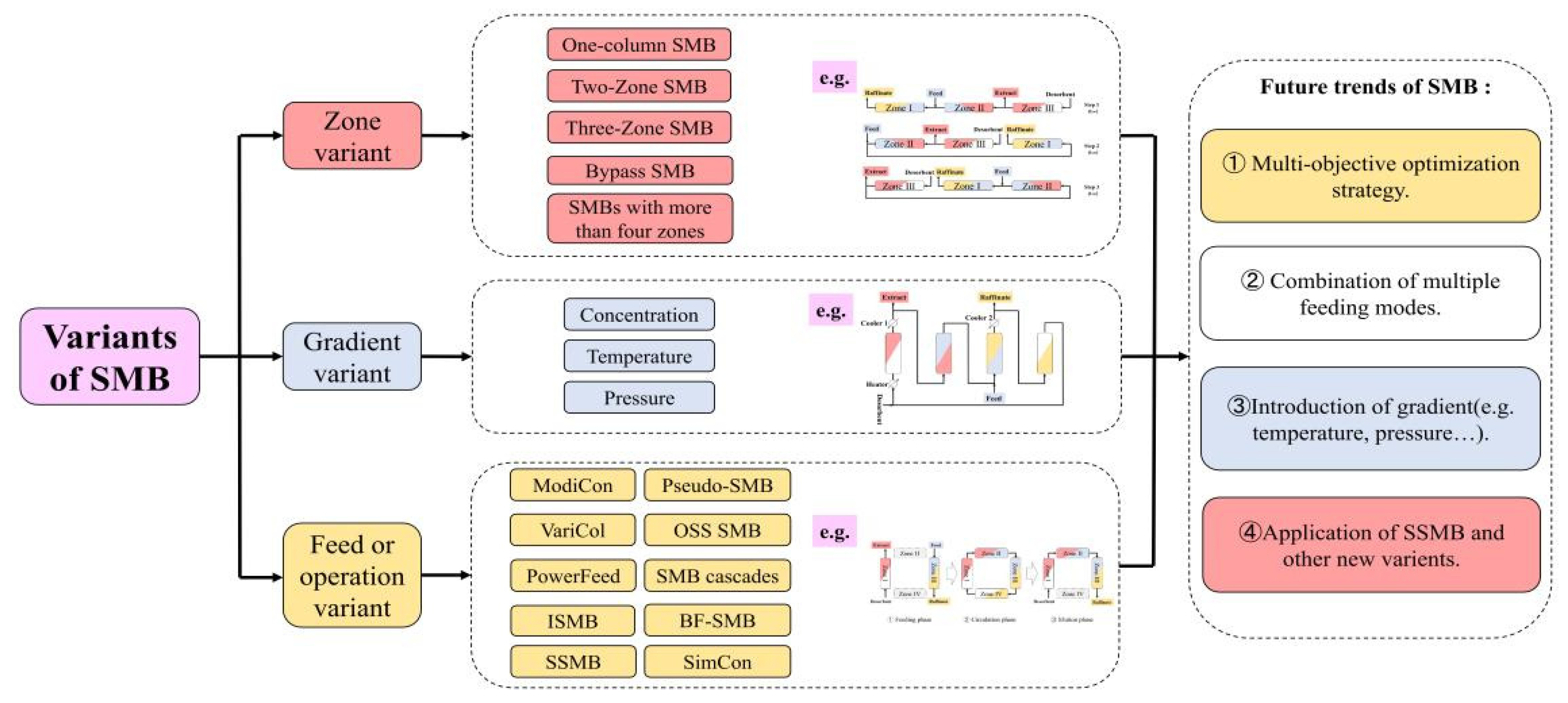
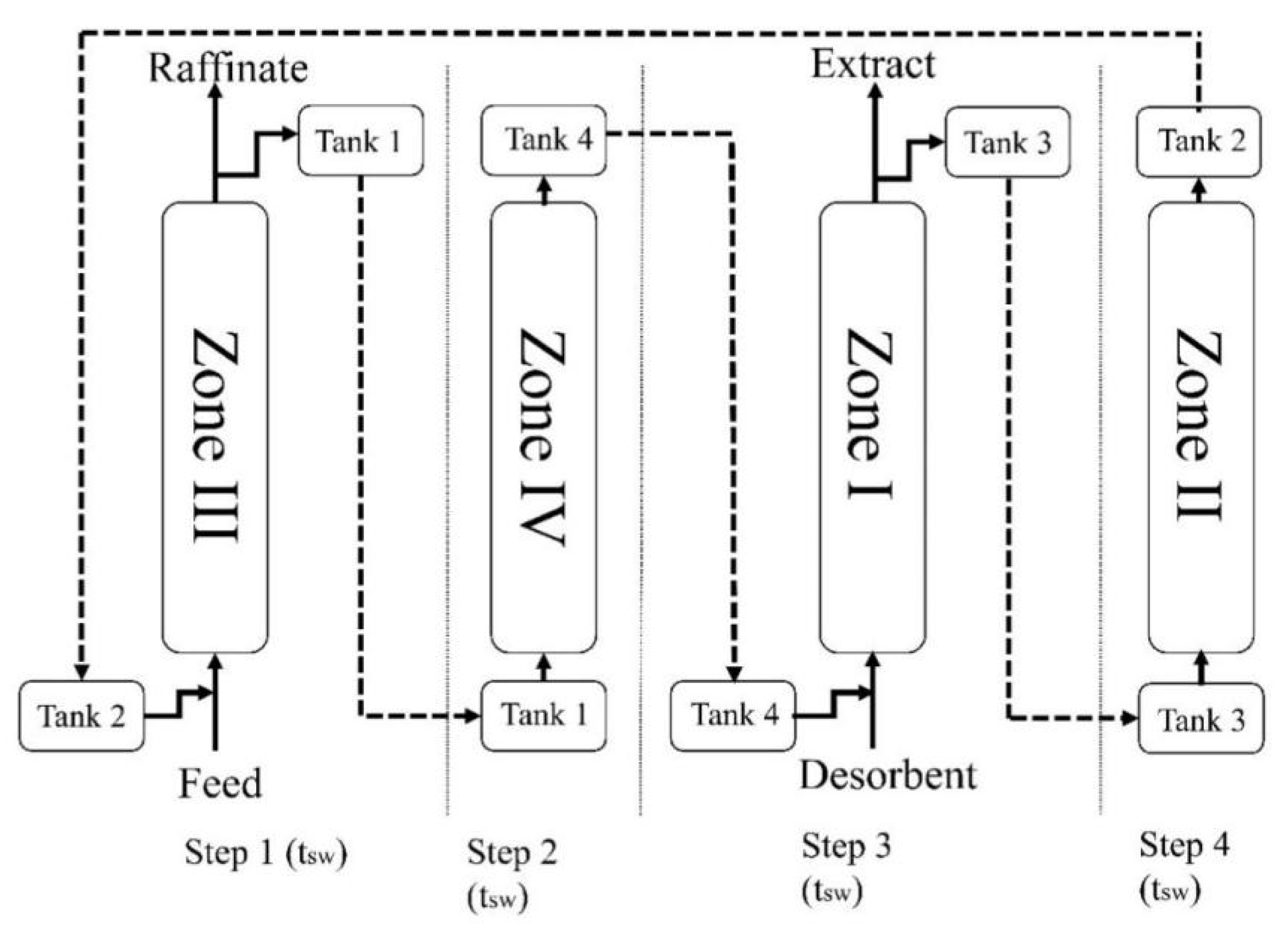
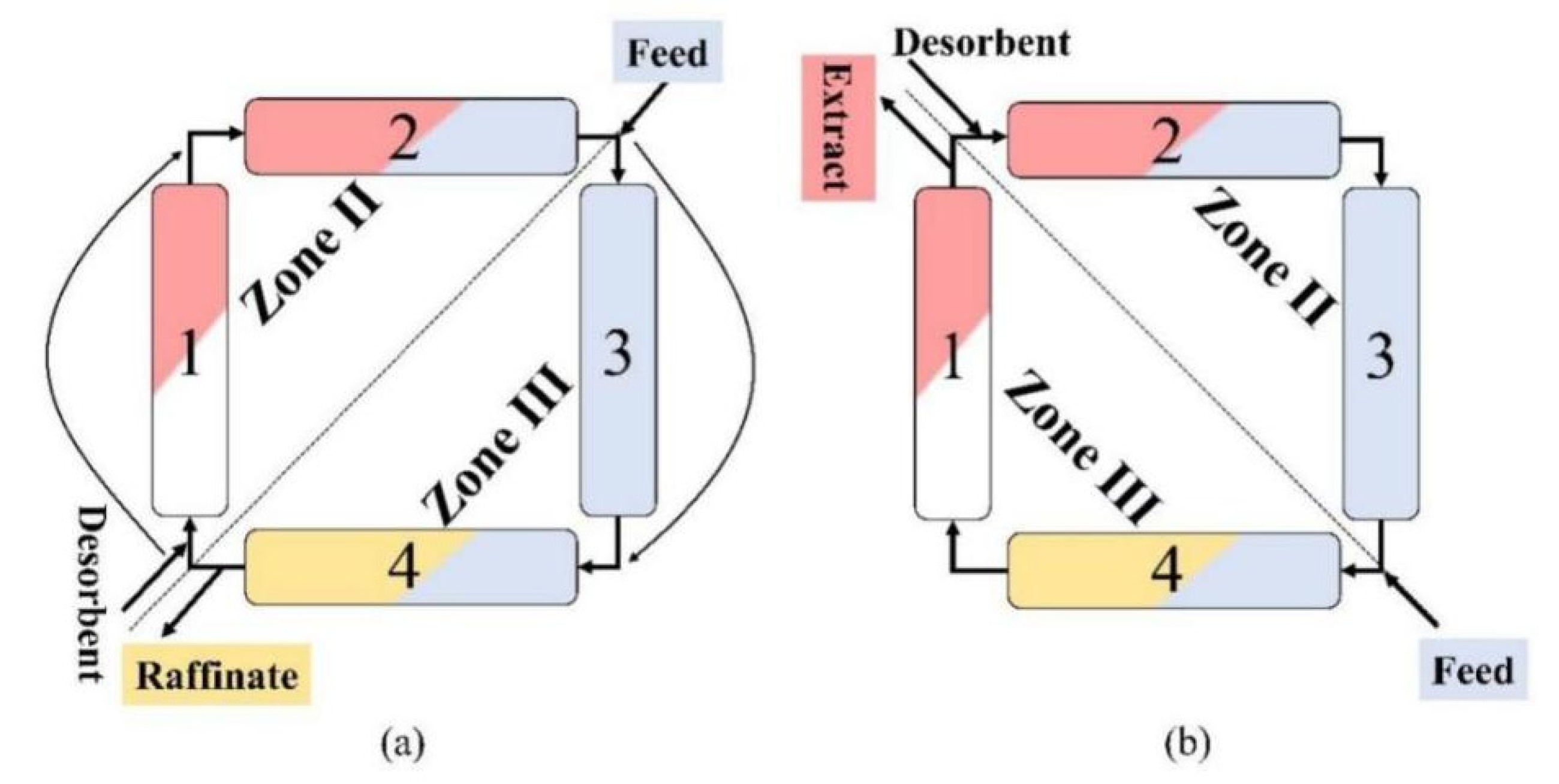


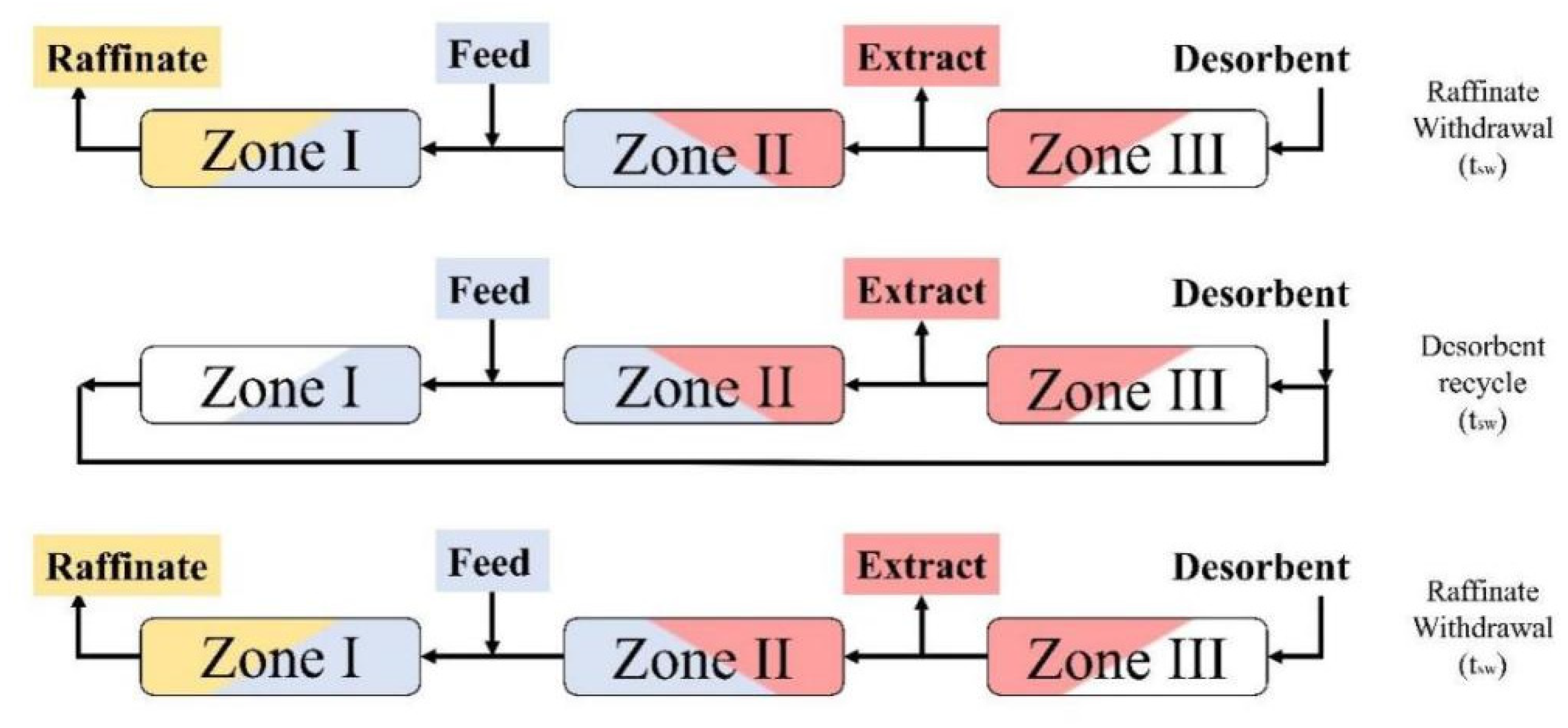
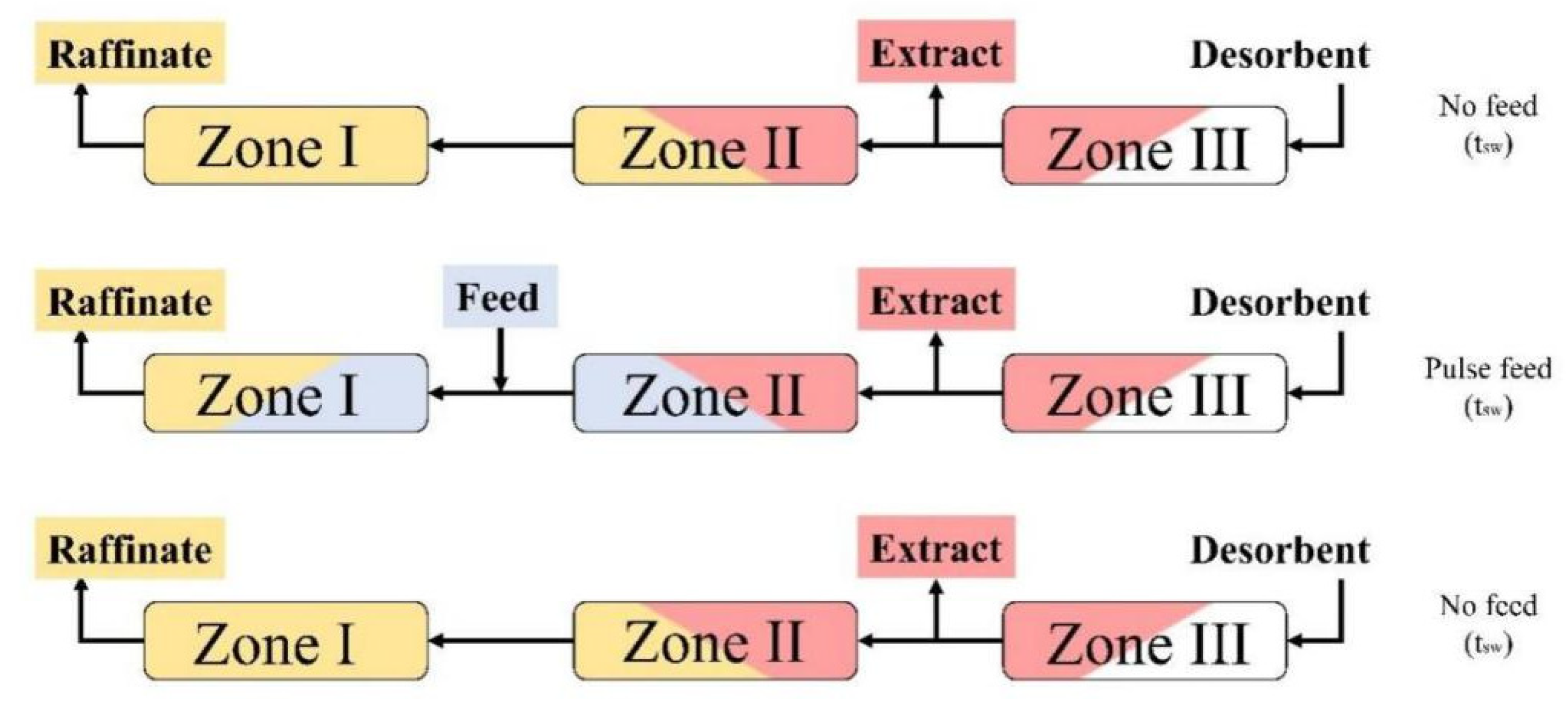



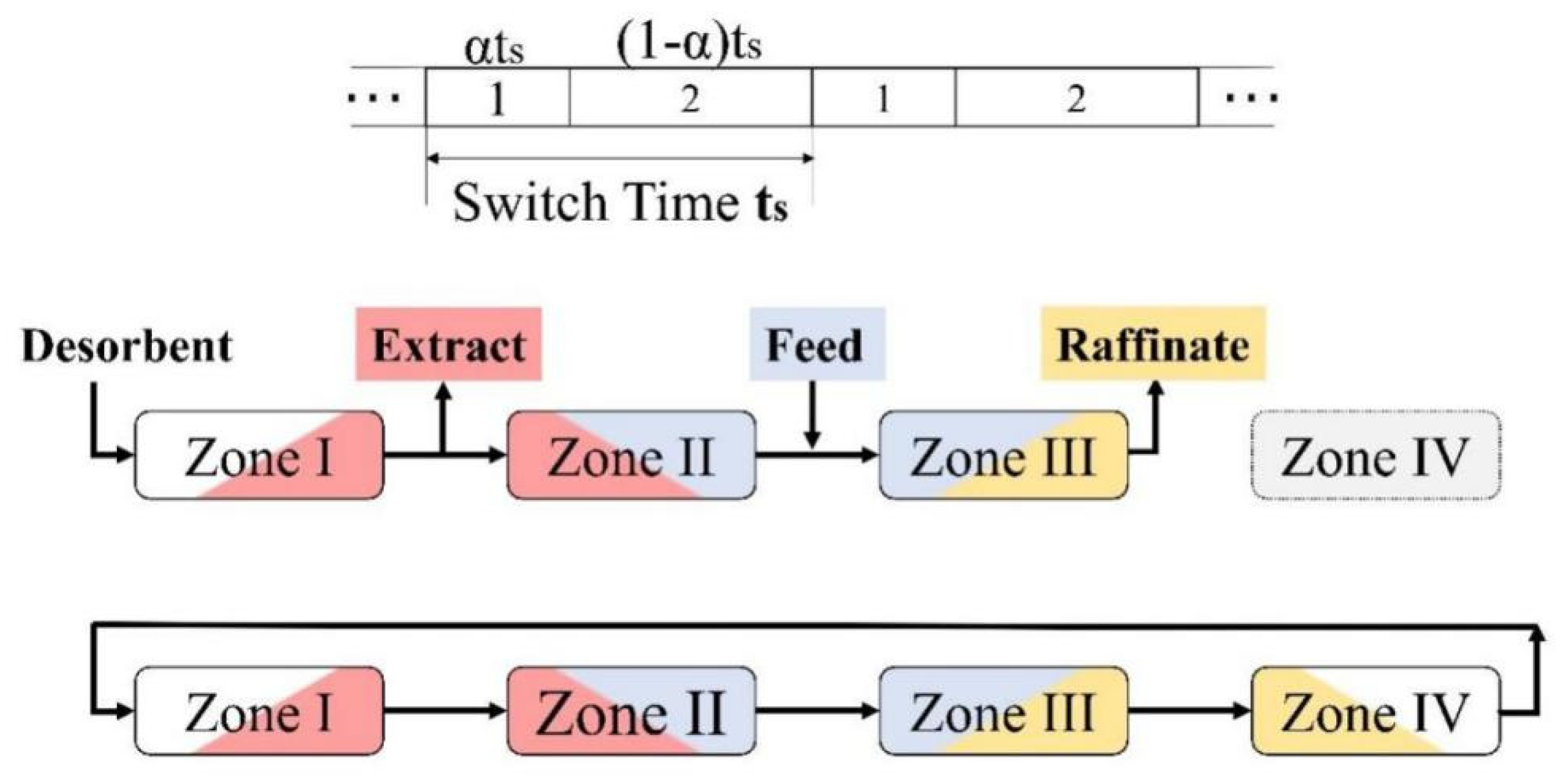

| Modification Mechanism | Switching Mode | Advantage | Disadvantage | Classification | |
|---|---|---|---|---|---|
| Zone variant | Non-essential functional zones are reduced by combing or deleting one or several columns. | Three-zone SMB possesses a unique three-step switching mode; the others’ is similar to the conventional SMB. | The economical efficiency is improved due to the simplified device and the better separation performance. | The solid and liquid phases cannot be adequately regenerated and recycled. | One-column SMB, two-zone SMB, three-zone SMB, bypass SMB, and SMBs with more than four zones. |
| Gradient variant | The adsorption behavior of each zone is adjusted by introducing a gradient parameter. | Similar to conventional SMB switching mode, basically. | Higher productivity, purity, and lower desorbent consumption can be achieved. | Poor stability, high design difficulty, may only be used under limited conditions. | Concentration gradient, temperature gradient and pressure gradient. |
| Feed or operation variant | The feed or operation mode is changed without altering the SMB configuration. | For VariCol mode, only one inlet or outlet is switched within each switching time, and each port is switched independently. SSMB has unique three step switching mode. Others’ are similar to that of conventional SMB. | High utilization of mobile phase and low water consumption. Complicated and multiple systems can by separated by this variant. | The operation and optimization works become more complex due to the internal instability. | ModiCon, VariCol, PowerFeed, ISMB, SSMB, Pseudo-SMB, OSS, BF-SMB, SMB cascades, SimCon. |
Disclaimer/Publisher’s Note: The statements, opinions and data contained in all publications are solely those of the individual author(s) and contributor(s) and not of MDPI and/or the editor(s). MDPI and/or the editor(s) disclaim responsibility for any injury to people or property resulting from any ideas, methods, instructions or products referred to in the content. |
© 2023 by the authors. Licensee MDPI, Basel, Switzerland. This article is an open access article distributed under the terms and conditions of the Creative Commons Attribution (CC BY) license (https://creativecommons.org/licenses/by/4.0/).
Share and Cite
Zhang, X.; Liu, J.; Ray, A.K.; Li, Y. Research Progress on the Typical Variants of Simulated Moving Bed: From the Established Processes to the Advanced Technologies. Processes 2023, 11, 508. https://doi.org/10.3390/pr11020508
Zhang X, Liu J, Ray AK, Li Y. Research Progress on the Typical Variants of Simulated Moving Bed: From the Established Processes to the Advanced Technologies. Processes. 2023; 11(2):508. https://doi.org/10.3390/pr11020508
Chicago/Turabian StyleZhang, Xiaotong, Juming Liu, Ajay K. Ray, and Yan Li. 2023. "Research Progress on the Typical Variants of Simulated Moving Bed: From the Established Processes to the Advanced Technologies" Processes 11, no. 2: 508. https://doi.org/10.3390/pr11020508
APA StyleZhang, X., Liu, J., Ray, A. K., & Li, Y. (2023). Research Progress on the Typical Variants of Simulated Moving Bed: From the Established Processes to the Advanced Technologies. Processes, 11(2), 508. https://doi.org/10.3390/pr11020508









